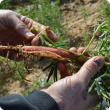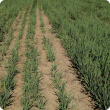Crops
The Department of Primary Industries and Regional Development continues to support the growth and international competitiveness of all crop industries in Western Australia.
With a 2400 kilometre span from its tropical north to its temperate south, WA supports a broad range of cropping industries from rain-fed winter cereals through to irrigated horticultural crops.
In the 2012/13 year the WA cropping industries exported a total of $3.9 billion which comprised: $3.1 billion of cereals, $859 million of pulses, pastures and oilseeds, $142 million of horticultural crops. The major contributors to these exports were wheat ($2.7 billion), canola ($756 million), barley ($377 million), lupins ($42 million), carrots at $48 million, oats ($12 million), and strawberries at $5.5 million.
Filter by search
Filter by topic
- (-) Remove Production & postharvest filter Production & postharvest
- Grains (190) Apply Grains filter
- Plant nutrition (98) Apply Plant nutrition filter
- Horticulture (85) Apply Horticulture filter
- Grains research & development (68) Apply Grains research & development filter
- Sowing (55) Apply Sowing filter
- Canola (53) Apply Canola filter
- Climate, land & water (50) Apply Climate, land & water filter
- Breeding & varieties (41) Apply Breeding & varieties filter
- Fertiliser (38) Apply Fertiliser filter
- Wheat (38) Apply Wheat filter
- Vegetables (36) Apply Vegetables filter
- Fruit (33) Apply Fruit filter
- Soil management (32) Apply Soil management filter
- Soils (32) Apply Soils filter
- Irrigation (22) Apply Irrigation filter
- Harvesting (22) Apply Harvesting filter
- Managing soils (21) Apply Managing soils filter
- Barley (21) Apply Barley filter
- Postharvest (20) Apply Postharvest filter
- Soil acidity (17) Apply Soil acidity filter
- Pulses (16) Apply Pulses filter
- Oats (15) Apply Oats filter
- Lupins (14) Apply Lupins filter
- Water (13) Apply Water filter
- Pests, weeds & diseases (13) Apply Pests, weeds & diseases filter
- Water management (12) Apply Water management filter
- Liming (12) Apply Liming filter
- Field peas (11) Apply Field peas filter
- Potatoes (10) Apply Potatoes filter
- Nursery & cutflowers (10) Apply Nursery & cutflowers filter
- Grapes & wine (9) Apply Grapes & wine filter
- Strawberries (8) Apply Strawberries filter
- Hay production (8) Apply Hay production filter
- Soil constraints (7) Apply Soil constraints filter
- Irrigated crops (6) Apply Irrigated crops filter
- Pastures (6) Apply Pastures filter
- Wine grapes (6) Apply Wine grapes filter
- Diseases (6) Apply Diseases filter
- Grains Research & Development (6) Apply Grains Research & Development filter
- Broccoli (6) Apply Broccoli filter
- Citrus (6) Apply Citrus filter
- Mangoes (5) Apply Mangoes filter
- Food, export & investment (5) Apply Food, export & investment filter
- Climate & weather (5) Apply Climate & weather filter
- Bananas (5) Apply Bananas filter
- Measuring and assessing soils (4) Apply Measuring and assessing soils filter
- Cauliflower (4) Apply Cauliflower filter
- Chickpeas (4) Apply Chickpeas filter














